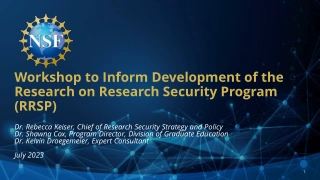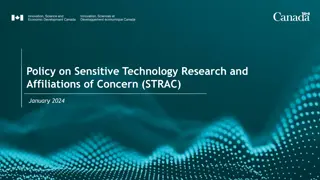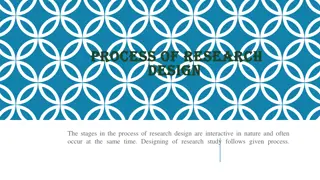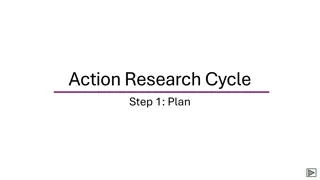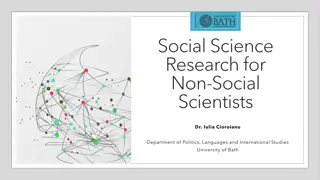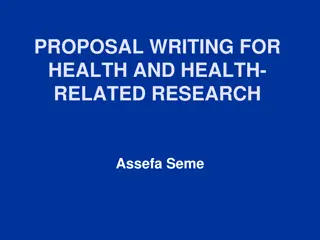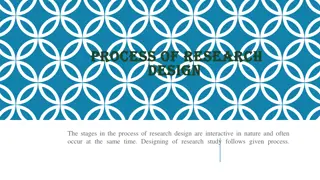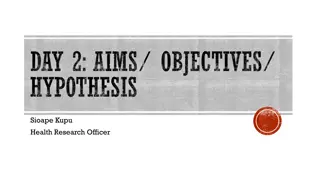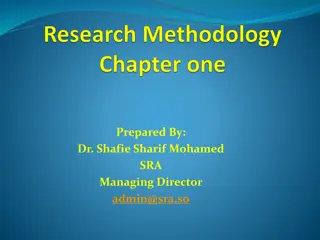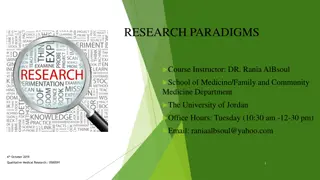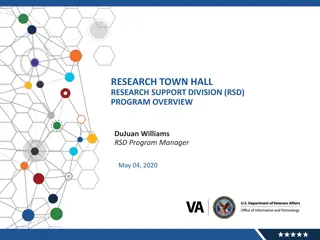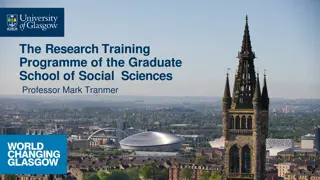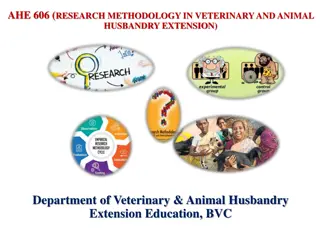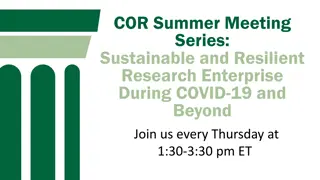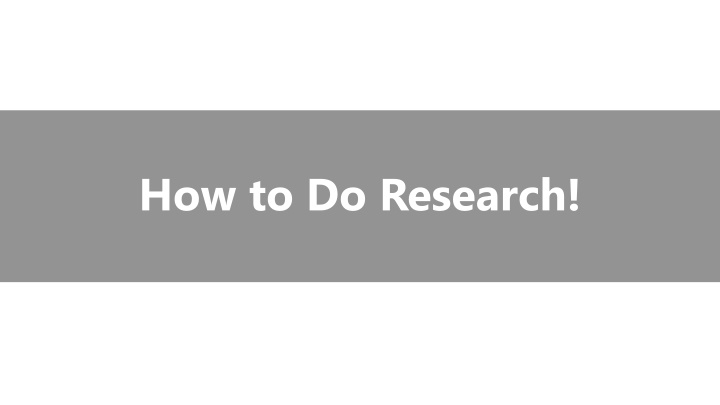
Mastering Research Skills: From Reading Papers to Developing Ideas
Learn essential research skills from reading and analyzing papers to developing unique ideas for your academic journey as a PhD student. Gain insights on how to effectively navigate through research materials and sources.
Download Presentation

Please find below an Image/Link to download the presentation.
The content on the website is provided AS IS for your information and personal use only. It may not be sold, licensed, or shared on other websites without obtaining consent from the author. If you encounter any issues during the download, it is possible that the publisher has removed the file from their server.
You are allowed to download the files provided on this website for personal or commercial use, subject to the condition that they are used lawfully. All files are the property of their respective owners.
The content on the website is provided AS IS for your information and personal use only. It may not be sold, licensed, or shared on other websites without obtaining consent from the author.
E N D
Presentation Transcript
Tips Learn to read papers and develop your taste One of the most common ways to generate new ideas is by reading other papers and getting inspired Pay special attention to the relevant seminar classes where you begin to read a ton of papers More importantly, find what types of papers interest you the most and ask yourself why. https://medium.com/digital-diplomacy/how-to-look-for-ideas-in-computer-science-research-7a3fa6f4696f
Your first year(s) as a PhD Student A growing group A lot of ideas are thrown at you A well-established group where your advisor no longer gives students concrete ideas to work on You have to come up with a research idea
Learn to read papers - The Three Pass Approach The first pass (5-10 min) Carefully read the title, abstract, and introduction Read the section and sub-section headings, but ignore everything else Read the conclusions Glance over the references, mentally ticking off the ones you ve already read The 5 C s Category What type of paper is this? A measurement paper? An analysis of an existing system? A description of a research prototype? Context Which other papers is it related to? Which theoretical bases were used to analyze the problem? Correctness Do the assumptions appear to be valid? Contributions What are the paper s main contributions? Clarity Is the paper well written? https://web.stanford.edu/class/ee384m/Handouts/HowtoReadPaper.pdf
Learn to read papers - The Three Pass Approach The Second pass (~1 hour) Look carefully at the figures, diagrams and other illustrations in the paper. Pay special attention to graphs. Are the axes properly labeled? Are results shown with error bars, so that conclusions are statistically significant? Remember to mark relevant unread references for further reading After this pass, you should be able to grasp the content of the paper. Goals Summarize the main thrust of the paper, with supporting evidence Sometimes you won t understand a paper even at the end of the second pass. New subject matter with unfamiliar techniques, terminology and acronyms The paper may be poorly written Or it could just be that it s late at night and you re tired Options Set the paper aside Return to the paper later Persevere and go on to the third pass https://web.stanford.edu/class/ee384m/Handouts/HowtoReadPaper.pdf
Learn to read papers - The Three Pass Approach The third pass (4-5 hours) Virtually re-implement the paper Make the same assumptions as the authors, Re-create the work Great attention to detail Identify and challenge every assumption in every statement Think about how you yourself would present a particular idea During this pass Jot down ideas for future work At the end of this pass Reconstruct the entire structure of the paper from memory Identify its strong and weak points Pinpoint Implicit assumptions Missing citations to relevant work Potential issues with experimental or analytical techniques https://web.stanford.edu/class/ee384m/Handouts/HowtoReadPaper.pdf
Tips Recognize patterns of developing research ideas Pattern #1: fill in the blank Pattern #2: expansion Pattern #3: build a hammer and find nails Pattern #4: start small, then generalize Pattern #5: reproduction of prior work Pattern #6: external sources: from industry, news feed, etc. https://medium.com/digital-diplomacy/how-to-look-for-ideas-in-computer-science-research-7a3fa6f4696f
Tips Develop a good habit of thinking about research ideas Realize that the execution of a project is fundamentally different from the generation and formulation of an idea. Take paper reviews seriously. Be curious and keep an open mind on what types of papers you might be interested in. Attend reading groups and talks often and ask questions. talk to your labmates often, get to know them personally, create a nice connection. https://medium.com/digital-diplomacy/how-to-look-for-ideas-in-computer-science-research-7a3fa6f4696f
You and Your Advisor Listen to your advisor. They won't always be right, but they have been doing research for (in some cases much) longer than you have When your advisor tells you to do something, do it. Ping your advisor If your adviser hasn t replied to an important email, remind them that you are waiting for their replyson and may not have seen your email or realized its importance. Feedback Make sure you obtain feedback from your advisor https://people.cs.umass.edu/~wallach/how_to_be_a_successful_phd_student.pdf
Meetings with Your Advisor Meet regularly. You should meet with your advisor regularly (e.g., weekly) Regular meetings with your advisor ensure that you are being productive and enable your advisor to give you feedback Make an agenda. Make an agenda for every meeting with your advisor Outline each of the topics that you'd like to cover If you don t know what you want to talk about, your advisor s unlikely to know either Bring results. Try to bring results (e.g., graphs, tables, figures) to every meeting Start with a summary. Summarizing the previous meeting Remind them what you agreed on as next steps, summarize what you've done (and haven t done) https://people.cs.umass.edu/~wallach/how_to_be_a_successful_phd_student.pdf
Picking a Research Topic Know the literature Know the community Think big It takes time Don t make up problems that don t exist Coming up with a new problem is great, but make sure it s real problem! https://people.cs.umass.edu/~wallach/how_to_be_a_successful_phd_student.pdf
The Research Start with writing Work out the details on paper first before you write any code Learn when to quit You can learn from failure, but only if you move on Don t be deadline focused There is always another deadline around the corner Publish interesting work when it s ready to be published Don t leave the writing to the end Start writing the paper as early as possible and aim to get results well before the deadline Writing will help you plan your work and think through your hypotheses and arguments You won t finish this work if you leave the writing to the night before the deadline Ask questions Don't be afraid to ask questions and/or ask for help Implement You understand best when you implement (understanding = intuition + math + code). If you can, implement things more than once (e.g., using two different methods, or in two different languages) and check your implementations give identical results. Version control Use version control for everything (notes, code, papers, etc.) https://people.cs.umass.edu/~wallach/how_to_be_a_successful_phd_student.pdf

